10 Best Desktop Replacement Laptops 2025
Ready to yeet your desktop out the window and replace it with the ultimate desktop replacement laptop?
Not so fast…
You’ve probably realized by now it’s not that simple.
What Kind of Laptop Do You Actually Need?
The right desktop replacement depends on:
✅ What kind of applications you used to run on your desktop
✅ What kind of user you are (gamer, creative, office worker, etc.)
✅ Any other specific needs (portability, battery life, weight, etc.)

Let’s be real—most people landing here are looking for a machine that can:
- Run games at ultra settings with triple-digit FPS
- Handle huge 3D models/simulations with buttery smooth viewport performance
- Or they just want a massive 17-inch display because bigger fonts = easier on the eyes
And of course, let’s not forget the people who miss their desktop’s ridiculous number of ports (that they never actually used but still want, just in case).
The Problem With “Desktop Replacement” Laptops
Google “desktop replacement laptop” and you’ll get pages of reviews hyping up:
- “Beast-like power” performance
- “Let the beast run wild” processors
- “Unleash the power of the Force” GeForce GPUs
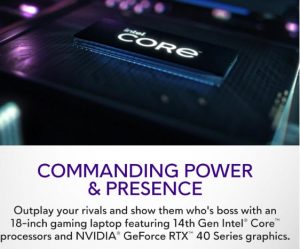
…yeah, okay. But what does that actually mean for you?
Most of these reviews never bother to explain why a laptop might be good for your specific needs—whether you’re a gamer or a professional.
Even worse? Some people just slap together a list of the ugliest, heaviest, most overpriced bricks imaginable without even considering specs-to-price ratios.
Why Design Actually Matters More Than You Think

Reality check: these so-called “beasts” can get HOT.
Better design = better cooling = better long-term performance.
A well-designed laptop will last you years, while a poorly designed one will start thermal throttling within months.
But let’s put that aside for a second…
Most People Don’t Actually Need a Ridiculous 10-lb Power Brick
Unless you absolutely need the most insane computing power available, you probably don’t need a giant, ugly, overpriced laptop that:
- Can’t even make it to Starbucks without dying halfway there
- Needs to be plugged in 24/7 or it’ll drain the entire building’s electricity
Most of these bricks aren’t even that useful for the average gamer or professional.
But—for the small group of people who actually need them? They’re absolute lifesavers.
Top 10 Best Desktop Replacement Laptops
In this article, we’re gonna cover some of those “let the beast run wild” laptops—except this time, with a much better specs-to-price ratio.
Oh, and we’re not just catering to people who need a 10-lb power brick—this list also includes laptops for the average gamer and everyday user.
So whether you’re:
✅ A 3D engineer, animator, or gamer needing serious GPU power
✅ A video editor looking for a high-performance workstation
✅ A home/office user who just wants something portable but still desktop-like
…you’ll find your ideal pick here.
Now… the + sign means you should get equal or greater. If you want to know which CPUs are faster check this post.
| Processor |
RAM | GPU | Display | Storage | |
| Business Movies 2D Games |
Core i3-10100U+ AMD Ryzen 3 5300U+ |
8GB for basic software 16GB for multitasking |
Doesn’t matter… | full HD for multitasking either TN or IPS |
512GB SSD |
| Heavy Photo Editing | Core i5 10210U | 16GB RAM | Any Dedicated GPU* | full HD IPS (+90% sRGB)* |
1TB SSD |
| Hardcore Gaming |
Core i5-11400H+ |
16GB for heavy games. 8GB for Light Games. |
4050RTX+ | FHD or QHD IPS over TN |
1TB SSD |
| Hardcore Video Editing |
Core i7-11400H Core i9-11900HK+ AMD Ryzen 7/9 HS+ |
32GB RAM | 4060RTX | QHD ideal. 4k better. | 1-2TB SSD |
| Hardcore 3D CAD/Animation | Core i7-11400H Core i9-11900HK+ AMD Ryzen 7/9 HS |
16-32GB RAM 32 for extreme large scenes/models |
4060RTX |
FHD or QHD | 1-2TB SSD |
The more complete & lengthy guide is on the last section of this post.
Take a look at this post: beginner’s guide to computer specifications if you are new to computer terminology and if there’s something you don’t understand.
Note there’s also a comparison table for CPUs and GPUs on the last section you can use as well.
1. Acer Predator Helios Neo 16
The Best Desktop Replacement Laptop
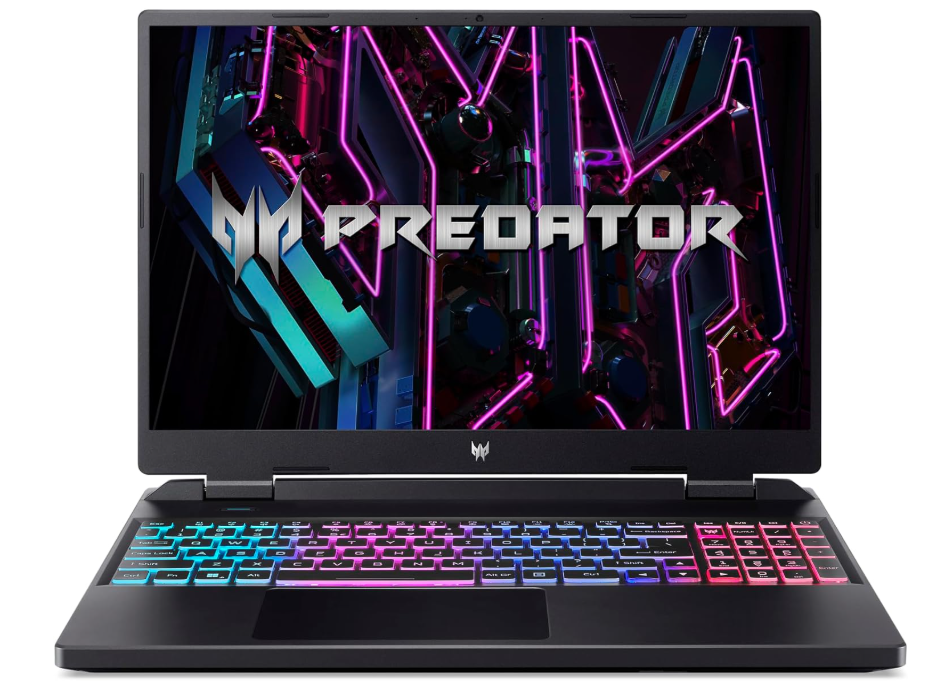
Intel Core i7-13650HX
16GB RAM DDR5
NVIDIA GeForce RTX 4060
512GB SSD PCIe NVMe
16” FHD IPS 165Hz
5.73 lbs
2 hours
The Acer Predator Helios Neo 16 is built for serious gamers and power users who want a desktop replacement without going all-in on ultra-premium pricing. This model brings RTX 4060 power, a high refresh rate display, and an Intel Core i7-13650HX that can handle heavy workloads.
If you’re coming from an older RTX 3060 (mobile) or GTX 1070 Ti, expect a noticeable boost in performance. It’s not quite desktop-level RTX 4060 power, but it’s close—somewhere between a desktop RTX 3060 Ti and RTX 3070 in real-world performance.
Performance: Gaming, Editing & Workloads
RTX 4060: How Well Does It Actually Perform?
- Baldur’s Gate 3 (Max Settings @ 60Hz Cap): 50-60 FPS, using only ~50% GPU load. No thermal throttling, stays smooth even in large battles.
- Cyberpunk 2077 (High Settings, DLSS On): 85+ FPS in most areas, 60-70 FPS in denser environments.
- Call of Duty MW3 (Ultra Settings, DLSS Balanced): 90-110 FPS, smooth performance with low input lag.
- Most Xbox Game Pass games run flawlessly at max settings, with no major stuttering issues reported.
Should you use the full 165Hz refresh rate?
Not really—unless you’re playing competitive shooters. Capping FPS to 60Hz (via NVIDIA Control Panel) saves battery, reduces GPU load, and keeps temps lower. One user capped FPS at 60Hz and saw big battery life improvements.
Thermals & Cooling: The Fan Turbo Button Actually Works
- Under normal gaming loads: 60°C (which is actually low for a gaming laptop).
- More demanding titles (Cyberpunk, Starfield, etc.): 70-75°C max—acceptable, but cooling pad recommended.
- Turbo Fan Mode: Massively drops temps but sounds like a jet engine (use headphones if you don’t want to hear it).
Pro Tip: A laptop stand helps a LOT with airflow—several users reported better cooling just by propping it up.
Battery Life: It’s a Gaming Laptop…
Let’s be real, gaming laptops aren’t made for unplugged gaming.
- Gaming on battery: 1-2 hours MAX, don’t even try.
- Casual use (web, streaming, work): 4-5 hours with 60Hz refresh rate + 20% brightness.
- One user found keeping the brightness at 20% made a big difference in battery life.
Display: Surprisingly Good for the Price
- 1920×1200 WUXGA resolution with G-SYNC (not QHD but still solid).
- Bright enough to be headache-inducing at max brightness (users keep it at 20%).
- Good color accuracy, wide viewing angles, and minimal backlight bleed.
- IPS panel means no weird color shifts from different angles.
If you work with photo/video editing, you might want an external monitor for 100% color accuracy, but for gaming, this screen is sharp and responsive.
Design & Build Quality
- Not lightweight but very sturdy—this thing feels built to last.
- **The RGB backlit keyboard is solid, no complaints about typing experience.
- **Has a full number pad, which is great for productivity.
- Speakers are… okay. Some users said they sound weaker than expected for a laptop this big (use headphones or external speakers for better audio).
Who Should Buy This?
✅ You want a gaming laptop that can double as a work machine without blowing past the $1,500 mark.
✅ You play AAA games and want high settings @ 60-100+ FPS without stuttering.
✅ You don’t mind a heavy laptop if it means better cooling and performance.
✅ You’re okay with tweaking settings (FPS caps, refresh rates) to optimize battery life.
⚠️ Who Should Look Elsewhere?
❌ If you need ultra-long battery life—this thing needs to stay plugged in for gaming.
❌ If you want a super lightweight laptop—it’s not unreasonably heavy, but it’s still a thick, cooling-focused gaming machine.
❌ If you care about perfect built-in audio—the speakers aren’t great.
2. Lenovo LOQ 15IRH8
Best Lenovo Desktop Replacement Laptop
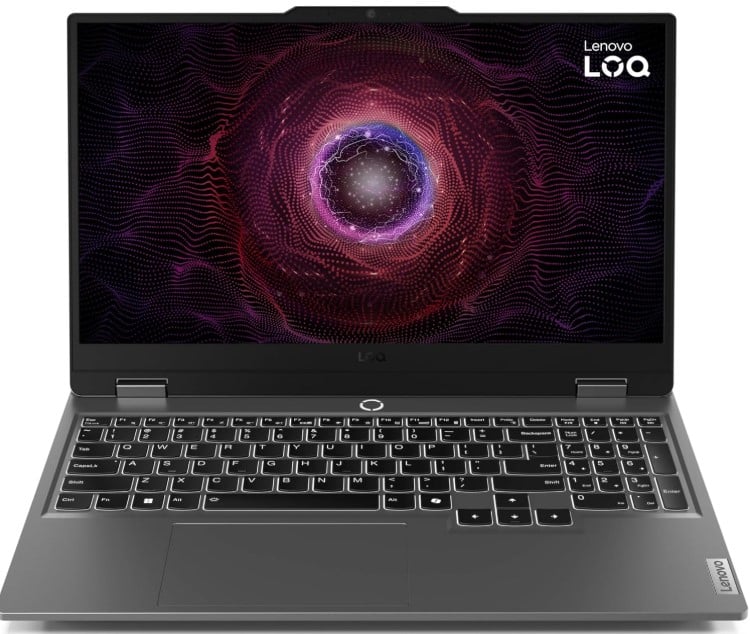
Ryzen 7 7435HS
16GB RAM
NVIDIA GeForce RTX 4050
512GB SSD PCIe NVMe
15” FHD IPS 144Hz
3.7 lbs
4 hours Web Surfing / 2 Interior Design
The ASUS Strix Scar series used to be the go-to for desktop replacement laptops, but let’s be real—times have changed. The Lenovo LOQ 15IRH8 delivers insane performance per dollar, packing an RTX 4050 and a Ryzen 7 7435HS into a compact 3.7 lb chassis without cutting corners. It’s not the most powerful gaming laptop out there, but for the price? Easily one of the best performance-to-cost machines you can get in 2025.
Hardware: Ryzen 7 7435HS + RTX 4050
Let’s talk specs. The Ryzen 7 7435HS and RTX 4050 combo is a killer setup for gaming, 3D work, and even video editing.
- CPU – Ryzen 7 7435HS: 8-core, 16-thread beast that holds its own against Intel’s latest chips in productivity workloads. AMD’s efficiency also means less heat, longer battery life, and consistent performance under load.
- GPU – RTX 4050 (6GB vRAM): This isn’t a top-tier card, but DLSS 3.0 and Frame Generation make it a way more viable desktop replacement than older RTX 20/30-series GPUs. It’s basically an RTX 3060 with better AI-assisted rendering.
And then there’s the 144Hz FHD display, which is pretty much the sweet spot for this hardware. You won’t hit 300Hz like older high-end gaming laptops, but honestly? Unless you’re a hardcore esports pro, 144Hz is all you need for smooth gameplay and fast UI responsiveness.
Performance
Gaming – The Sweet Spot for 1080p
The RTX 4050 might not sound impressive in 2025, but DLSS 3.0 makes a massive difference. With Frame Generation, you’re seeing FPS boosts of 40-50% in modern titles. Here’s what you can expect at high settings, 1080p:
- Cyberpunk 2077 (RT Medium + DLSS 3.0) → 80-100 FPS
- Call of Duty: MW3 → 100+ FPS
- Baldur’s Gate 3 → 90+ FPS
- Fortnite (Epic + DLSS 3.0) → 140+ FPS
For competitive games like Valorant or Apex Legends, the 144Hz refresh rate gets fully utilized. And for single-player titles, RTX 4050 still keeps up in 2025.
3D Modeling & GPU Workloads
For CAD, 3D modeling, and rendering, 6GB vRAM is enough for most workflows. Blender’s OptiX AI Denoising and CUDA acceleration mean rendering is faster than RTX 3060 laptops from previous years.
If you’re a hardcore 3D artist working on massive assemblies, you might want an RTX 4060 or higher, but for most people, the RTX 4050 is more than enough for professional work without jumping into workstation laptop territory.
Video Editing & Productivity
- Davinci Resolve & Premiere Pro: Hardware acceleration via CUDA makes export times quick, and the Ryzen 7 7435HS crushes multi-threaded workloads.
- Photo Editing: Lightroom and Photoshop eat this hardware for breakfast—no delays, no lag, even with multiple RAW files open at once.
- Programming & Multitasking: 16GB RAM + Ryzen 7 means compiling code, running VMs, or stacking 50 Chrome tabs won’t slow you down.
Build & Design: Subtle, Not Over-The-Top
Unlike older Strix Scar models that screamed “I am a gaming laptop”, the Lenovo LOQ 15IRH8 keeps things clean. No ridiculous RGB puke, no aggressive red accents, just a solid black chassis that fits in anywhere.
Cooling is also well-managed. Lenovo laptops have some of the best thermals in the game, and the dual-fan setup with larger heat pipes keeps the CPU and GPU from throttling under load. Fans will definitely ramp up under stress, but headphones fix that problem real quick.
Battery Life – Still a Weak Spot (As Expected)
- 4 hours of web browsing? Not bad.
- 2 hours of heavy workloads? Yeah, you’ll need the charger nearby.
This is normal for gaming laptops, so if you’re expecting MacBook-level battery life, you’re looking in the wrong category. This thing is meant to be plugged in most of the time—no surprise there.
Upgradability & Ports – No Complaints
- RAM: Expandable to 32GB DDR5 (which is nice if you need more multitasking power).
- Storage: M.2 NVMe SSD slot + extra storage bay = easy upgrade path.
- Ports: HDMI, USB-C, Ethernet, and multiple USB-A ports—everything you’d expect from a desktop replacement.
Unlike some laptops that are a nightmare to open, Lenovo actually lets you upgrade stuff without fighting the chassis. Big win.
Final Verdict – Is It a True Desktop Replacement?
The Lenovo LOQ 15IRH8 isn’t a maxed-out flagship, but for the price, it delivers. An RTX 4050 with DLSS 3.0, a Ryzen 7 CPU, and solid cooling make it one of the best budget-friendly desktop replacements in 2025.
Who should buy this?
✅ Gamers who want 1080p high-refresh gaming without breaking the bank
✅ Creatives who need a budget-friendly laptop for Photoshop, Blender, or Premiere Pro
✅ Power users who want a fast CPU, upgradability, and a clean design
Who should look elsewhere?
❌ Anyone needing top-tier GPU power (RTX 4060/4070 is better for heavy 3D work)
❌ People expecting all-day battery life
❌ Users who need a higher-res screen (FHD is great, but no QHD/4K option here)
3. Lenovo Ideapad Gaming 3
Best Budget Desktop Replacement Laptop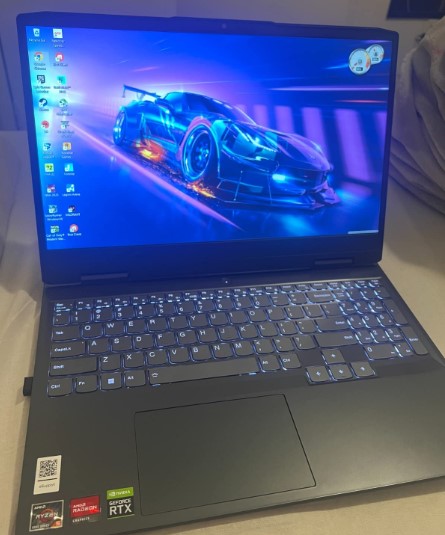
AMD Ryzen 5 6600H
8GB DDR4
NVIDIA GeForce GTX 3050 4GB vRAM
256GB PCIe NVMe
15” Full HD IPS 144Hz refresh rates
5.06 lbs
5 hours
Best for Architects w/ Medium-Large BIM Models
4. ASUS ROG Nebula
Most Powerful Desktop Replacement Laptop
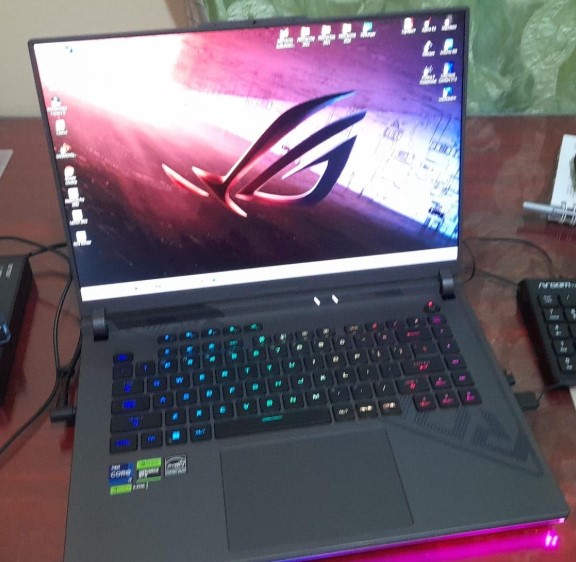
Core™ i9-14900HX
16GB DDR5
RTX 4070 140W
1TB PCIe Gen4
16” QHD 240Hz
5.5 lbs
>1 hour
If you’re looking for the ultimate powerhouse laptop in 2025, the ASUS ROG Strix G16 (2024) is it. This thing isn’t just a gaming laptop—it’s a full-on desktop replacement with a high-end i9-14900HX CPU, an RTX 4070, and a stunning QHD 240Hz display.
5. HP Victus 15 fa0025nr
Budget Desktop Replacement Laptop under 900

Core i5 12500H
8GB DDR4
RTX 3050Ti 4GB vRAM
512GB PCIe SSD
15” 60Hz Full HD
5.73lbs
5 hours
6. HP Omen 17t
HP Desktop Replacement Laptop
AMD Ryzen 7 8845HS
32GB RAM DDR5
NVIDIA GeForce RTX 4050 (6GB vRAM)
1TB SSD (PCIe Gen 4)
17.3” FHD (1920×1080) 48-144Hz Adaptive Refresh Rate
3-4 Hours (Web Browsing) / ~1 Hour (Gaming)
The HP Omen 17 is a large-screen powerhouse built for gamers, creatives, and anyone who needs serious power in a portable form. The combo of an AMD Ryzen 7 8845HS and RTX 4050 (6GB) gives you high-end performance without the ridiculous price tag of 4080+ laptops.
If you’re looking for a true desktop replacement that can handle AAA gaming, content creation, and productivity work while staying somewhat budget-friendly, this might be the best 17” option available in 2024.
Performance: How Well Does It Actually Hold Up?
RTX 4050 (6GB vRAM) – Can It Handle Modern Games?
The RTX 4050 isn’t the most powerful GPU in NVIDIA’s lineup, but don’t let that fool you—this thing can handle modern AAA games at high settings, 60+ FPS with ease, especially at 1080p.
- Baldur’s Gate 3 (High-Ultra @ 1080p, DLSS On): 80-100 FPS in most areas, 55+ FPS in heavy combat.
- Cyberpunk 2077 (High Settings, DLSS Balanced): 70-90 FPS, smooth with little stutter.
- Call of Duty MW3 (Ultra @ 144Hz Cap): 85-120 FPS, no major frame dips.
- Most eSports titles (Valorant, CS2, Apex) push well over 144 FPS, making the 144Hz screen actually useful.
While the RTX 4050 won’t compete with an RTX 4070 or higher, it’s way more power-efficient, meaning lower heat, better battery life, and more stable performance over time.
If you’re coming from an older GTX 1660 Ti or RTX 3060, this is a noticeable upgrade.
AMD Ryzen 7 8845HS: Solid for Gaming & Productivity
The Ryzen 7 8845HS is an 8-core, 16-thread processor with a boost clock up to 5.1GHz. It’s not just a gaming chip—it’s great for content creation, streaming, and multitasking.
- Video Editing (Premiere Pro, DaVinci Resolve): Fast exports, handles 4K timelines well.
- 3D Modeling (Blender, AutoCAD, SolidWorks): Can handle complex assemblies, but for heavy rendering, an RTX 4060+ would be better.
- Streaming (OBS, Twitch, YouTube): Handles 1080p 60FPS streaming while gaming without frame drops.
Cooling & Thermals: Not Bad for a 17” Beast
Gaming laptops this size tend to run hot, but the HP Omen 17’s cooling system is surprisingly effective.
- Normal Gaming Temps: 65-75°C (GPU) | 75-80°C (CPU)
- Heavy Load Temps (AAA games, Rendering): 80-85°C (manageable but noticeable fan noise)
- Turbo Mode / Max Fan Speed: Drops temps by ~5-10°C but gets loud (use headphones)
If you’re gaming for long sessions, a cooling pad or laptop stand will help a lot.
Battery Life: Don’t Expect Magic, It’s a 17” Gaming Laptop
Yeah, you already know the deal—big gaming laptops = bad battery life.
- Gaming on Battery: 1 hour (maybe 90 minutes if you cap FPS & lower brightness).
- Casual Use (Web, Streaming, Office Work): 3-4 hours with lower refresh rate & brightness.
- Pro Tip: Setting the refresh rate to 60Hz in Windows Settings when unplugged helps stretch battery life.
Display: 17.3” FHD with 48-144Hz Adaptive Refresh
The biggest selling point of this laptop is the display—17.3” of smooth, high-refresh-rate goodness.
- FHD (1920×1080) resolution keeps frame rates high (1440p would be great, but at this price, it’s a fair trade-off).
- Adaptive refresh rate (48-144Hz) prevents screen tearing and stuttering.
- Bright enough for indoor use (but don’t expect MacBook Pro brightness levels).
- Great viewing angles, colors are accurate but not pro-grade (good for gaming, decent for creative work).
If you edit photos or videos, you might want to calibrate the display or use an external monitor for perfect color accuracy.
Design & Build Quality
- Looks sleek but still has a gaming vibe—RGB keyboard, clean design, not obnoxious like some gaming laptops.
- Keyboard is solid, full-size with numpad (good for work + gaming).
- Trackpad is decent but… it’s a gaming laptop, use a mouse.
- Plenty of ports: USB-C, HDMI, RJ45 Ethernet, and Wi-Fi 6E for fast connectivity.
The weight isn’t listed, but expect it to be ~6 lbs, which is standard for a 17” gaming laptop.
Who Should Buy This?
✅ You want a big screen, high refresh rate gaming laptop that doesn’t break the bank.
✅ You play AAA games and want 60+ FPS on High-Ultra settings.
✅ You need a powerful CPU for gaming, content creation, or streaming.
✅ You’re okay with average battery life (because you mostly game plugged in).
⚠️ Who Should Look Elsewhere?
❌ If you need an ultra-light, portable laptop. (This is a desktop replacement, not a thin-and-light.)
❌ If you do pro-level video editing/color grading. (The display is great for gaming but not color-accurate enough for professional work.)
❌ If you want extreme battery life. (Gaming laptops this size aren’t built for unplugged gaming.)
Final Verdict: Is the HP Omen 17 Worth It?
For under $1,500, this is one of the best 17” gaming laptops available. The combination of an RTX 4050 (6GB), Ryzen 7 8845HS, and 32GB of DDR5 RAM makes it a great option for gamers, content creators, and multitaskers.
🔥 TL;DR: Big screen, strong performance, solid cooling. If you need a 17” gaming laptop that won’t destroy your wallet, this one’s a steal. 🚀
7. MacBook M4 Pro Chip
Best Desktop Replacement MacBook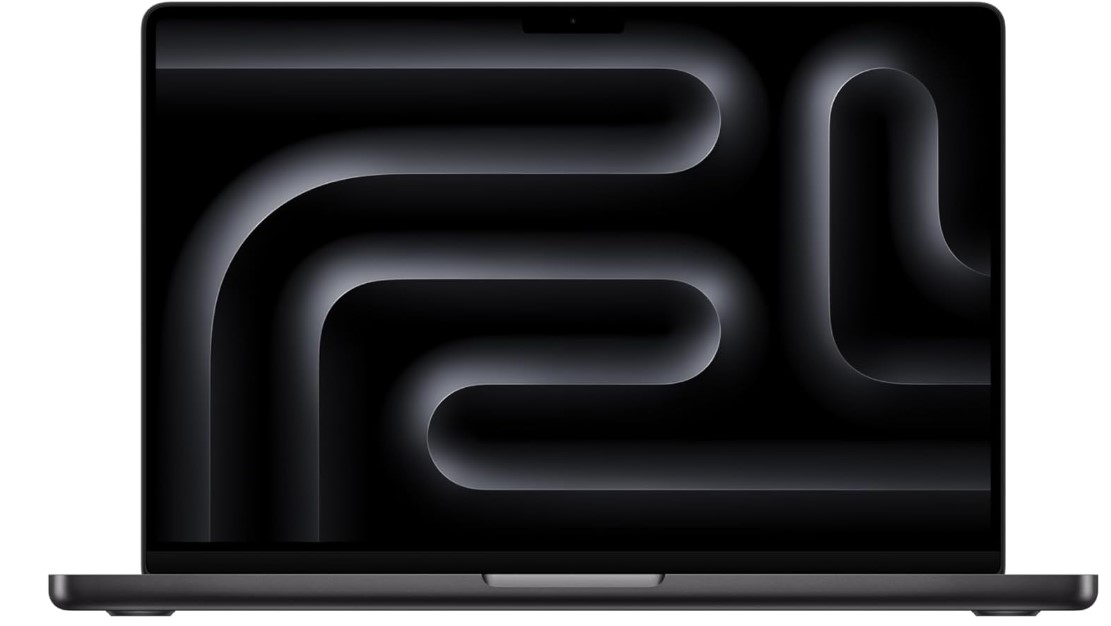
M4 12 Core CPU
24 GB Unified Memory
16‑core GPU
512GB-2TB SSD
14.2-16 inch Liquid Retina XDR display 3024-by-1964
4.7lb
13 hours
Hardware: Pure MacBook Pro Energy
If you need desktop-tier performance in a portable form, this is it. The M4 Pro chip makes this one of the fastest laptops on the market for creative professionals, and it does all of that while keeping whisper-quiet cooling and best-in-class battery life.
The 16-core GPU may not match high-end RTX cards for gaming, but Apple doesn’t play that game—instead, this GPU is optimized for photo/video editing, 3D modeling, and AI-enhanced workflows. The unified memory architecture also gives it a huge advantage over traditional laptops by dynamically sharing RAM between the CPU and GPU.
This laptop is basically a Mac Studio in a portable shell.
Performance: Unreal Power for Creative Pros
Apple M4 Pro – A Creative Beast
- Video Editing (Final Cut Pro, DaVinci Resolve, Premiere Pro):
✅ Flies through 4K and even 8K video editing.
✅ Real-time playback with multiple effects applied, no pre-rendering needed.
✅ Faster exports than most Windows machines (especially in Apple-optimized software). - 3D Rendering (Blender, Cinema 4D, Maya):
✅ Handles complex scenes surprisingly well for a non-RTX GPU.
✅ Great for motion graphics & 3D modeling, but not a replacement for high-end CUDA GPUs. - Photography & Graphic Design (Photoshop, Lightroom, Illustrator, Affinity Suite):
✅ Snappy, instant performance on large RAW images.
✅ AI-powered tools run better than on most Windows laptops due to Apple’s optimization.
✅ Color accuracy is unmatched—what you see is exactly what you get.
For Gaming?
Look, this isn’t a gaming laptop. macOS still doesn’t have great support for many AAA games, though the M4 Pro GPU can run macOS-native titles like Baldur’s Gate 3 and Resident Evil Village smoothly. If gaming is your main priority, stick to a Windows laptop with an RTX GPU.
Battery Life: No Comparison
One of the biggest flexes of Apple Silicon is battery life.
- Light work (writing, web browsing, casual use): 12-14 hours ✅
- Creative workflows (video editing, Photoshop, heavy multitasking): 7-10 hours ✅
- Absolute max performance load (exporting 4K/8K video, running AI-enhanced tools): 4-6 hours ✅
Compare this to a Windows workstation laptop, where you’re lucky to get 2 hours of battery life under load, and the MacBook crushes the competition.
Display: Liquid Retina XDR – The Best Laptop Screen Ever?
MacBooks have always had insane displays, and the Liquid Retina XDR remains the gold standard for professionals.
- 3024×1964 (14”) / 3456×2234 (16”) resolution – sharper than most 4K displays.
- Extreme Dynamic Range (XDR) – up to 1,600 nits peak brightness (HDR content looks unreal).
- P3 wide color gamut & True Tone – industry-leading color accuracy.
- 120Hz ProMotion – buttery smooth motion.
If you edit photos, color grade videos, or just want the best-looking screen, this is it. Even OLED gaming laptops don’t match this level of color accuracy.
Build Quality & Portability: Premium, as Expected
- Unibody aluminum design – sleek, durable, no flex, no creaks.
- Weight: 4.7 lbs for the 16” model – not the lightest, but still super portable.
- Ports: USB-C / Thunderbolt 4, SD card slot, HDMI, MagSafe charger – finally, the ports creative pros actually need.
- Keyboard & Trackpad: Best in class. Period.
Apple still dominates trackpad quality. If you’ve used one, you know what I mean.
Who Should Buy This?
✅ Creative professionals who need desktop power on the go.
✅ Video editors, 3D artists, motion designers, photographers.
✅ Mac users who want the best laptop experience possible.
✅ Anyone tired of gaming laptop battery life lasting 90 minutes.
⚠️ Who Should Look Elsewhere?
❌ Gamers – macOS gaming still isn’t great. If gaming is a priority, get an RTX-powered Windows machine.
❌ Budget-conscious buyers – The MacBook Pro is amazing but expensive. If you’re not using it for pro-level work, a MacBook Air might be enough.
❌ Those who need upgradeability – RAM & storage are soldered—choose wisely at checkout.
Final Verdict: Is the MacBook Pro M4 Worth It?
If you need a powerful laptop for professional creative work, the MacBook Pro M4 is basically unbeatable.
🔥 TL;DR: Insane battery life, the best display on any laptop, and performance that rivals desktops. If you’re a creative pro, this is the ultimate laptop. 🚀
8. HP TPN-I139
Cheap HP Desktop Replacement Laptop
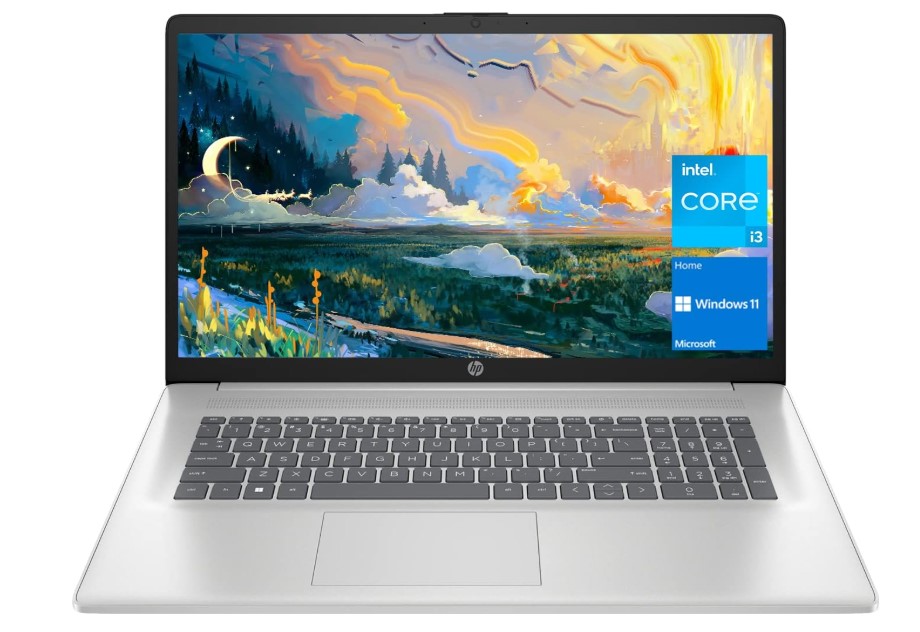
9. HP Laptops 17 inch
HP Desktop Replacement Laptop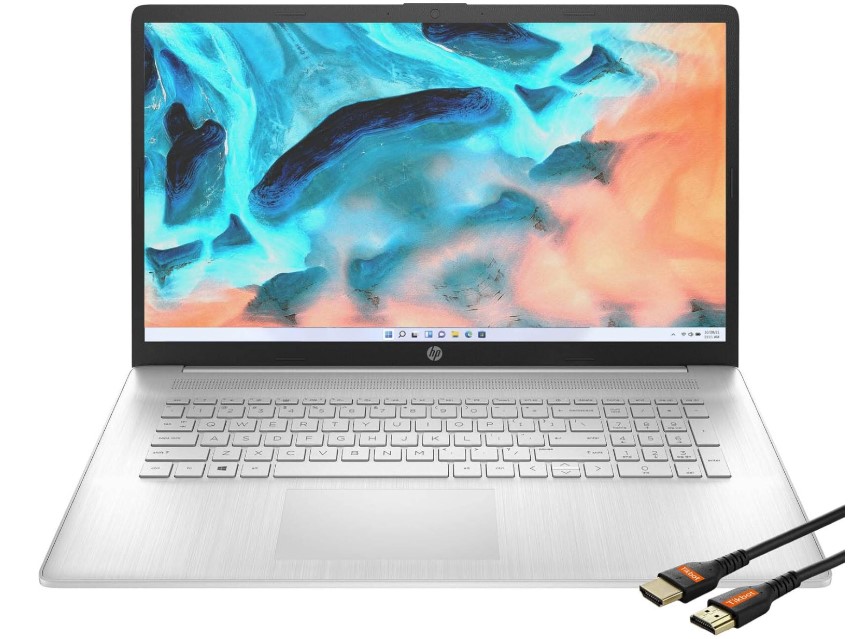
AMD Ryzen 5 5500U (6-Core, Beats Intel i7-1250U in Multitasking)
32GB RAM
Integrated Radeon Graphics
1TB SSD
17.3” Full HD (1080p) IPS Display
~5.3 lbs
~5-6 hours of battery life
Why Is This $600 and Not $300?
If you saw the $300 HP 17 and thought, “Why pay double for this one?” here’s the deal:
✅ WAY more power – The Ryzen 5 5500U destroys the Intel i3 in speed, multitasking, and performance. If you’re doing anything beyond basic web browsing, the extra processing power is worth every penny.
✅ Massively upgraded RAM (32GB vs 8GB) – No contest. This laptop can actually handle heavy multitasking, big spreadsheets, and even some light creative work.
✅ 1TB SSD (vs 256GB SSD) – You won’t run out of storage anytime soon. No worrying about constantly deleting files or using external drives.
✅ Full HD Display (1080p vs HD+ 1600×900) – Text, videos, and images are sharper, clearer, and just look better overall.
✅ Windows 11 Pro vs Windows 11 Home – Extra features for business users, better security, and more control over updates and settings.
✅ Fingerprint Reader – More convenient and secure than typing in passwords every time.
Simply put: this isn’t just a more expensive version of the $300 HP 17—it’s a whole different level of laptop.
Hardware
For $600, this laptop is shockingly well-specced for the price.
- The Ryzen 5 5500U beats Intel’s i7-1250U in most real-world multitasking scenarios. Whether you’re running Excel, handling big documents, or juggling multiple tabs, this thing won’t choke like the cheaper models.
- 32GB RAM = true multitasking beast. The cheaper HP 17 (8GB) will start lagging if you push it too hard—this one won’t.
- 1TB SSD – Not just extra storage, but faster speeds compared to old-school hard drives.
For everyday use, this thing flies compared to budget laptops.
Performance: Actually Fast Enough for Work
✅ Work & Productivity (MS Office, Zoom, Google Docs, Light Editing): Zero issues. Handles large spreadsheets, multiple apps open at once, and 20+ browser tabs without breaking a sweat.
✅ Casual Use (Web Browsing, Streaming, Email): No slowdowns, no stuttering, just smooth performance.
✅ Photo & Video Editing (Light Photoshop, Basic Video Work): The extra RAM helps, but it’s still an integrated GPU, so don’t expect professional-level editing speeds.
✅ Casual Gaming (Minecraft, Sims, Indie Titles): Playable, but this is not a gaming laptop. If you want gaming performance, get a model with a dedicated GPU.
❌ Who should look elsewhere?
- Gamers: This isn’t built for AAA titles. Stick to lighter games or look for a laptop with an RTX card.
- 3D Rendering / Heavy Video Editing: The CPU is decent, but you’ll need a dedicated GPU for serious creative work.
For regular users, students, professionals, and even light creative work, this laptop offers fantastic performance for the price.
Battery Life: Decent for a 17-inch Laptop
Expect around 5-6 hours of real-world use with general tasks. If you’re watching videos or running heavier applications, battery life will drop. But considering the power inside, this is totally acceptable.
Display: A Huge Step Up from the $300 Model
The 17.3” Full HD IPS display makes a huge difference compared to the cheaper model’s HD+ panel:
✅ Text is sharper, images are clearer, and colors look better.
✅ Great for watching movies, working with spreadsheets, or multitasking.
✅ IPS panel = better viewing angles and more accurate colors.
For anyone who spends hours in front of a screen, this upgrade alone is worth it.
Build & Design: Practical and No-Nonsense
- Feels solid and sturdy – No cheap plastic feel, despite the budget price.
- Backlit keyboard would’ve been nice, but not a dealbreaker.
- Fingerprint reader = convenient and secure.
- Still weighs around 5.3 lbs, so not super portable, but fine for a home or office laptop.
Who Should Buy This?
✅ Students & Professionals who need reliable performance and a big screen.
✅ Work-from-home users running Zoom, MS Office, and productivity apps.
✅ Casual users who want fast performance, lots of storage, and a better screen.
✅ Light creative users (basic Photoshop, light video editing) who don’t need a GPU.
❌ Who Should Skip This?
❌ Gamers – Integrated graphics won’t cut it. Look for a laptop with an RTX 3050 or higher.
❌ Power users – If you edit 4K videos, do heavy 3D work, or need pro-level color accuracy, look elsewhere.
10. Lenovo 330 17.3″
Best Desktop Replacement Laptop For Basic Users
Intel Core i5-1335U (10-Core, 12-Thread, Turbo up to 4.6GHz)
How To Buy The Best Desktop Replacement Laptop
When you type “desktop replacement laptop” into the Amazon or Google search bar, you usually get 17-inch laptops thick enough to be used as snow shovels, packed with the latest GPU and CPU, and sitting at the top of the search results.
While these definitely have all the “beast-like” and “unleashed power of the force” performance, very few people will put all that power to full use—and I mean VERY, VERY few (about 0.01%).
Even among those who actually need that power, most aren’t getting the best bang for their buck.
Their price tags are ridiculously high, too! You could literally buy dozens of Chromebooks for the price of one of these monsters—enough to give every kid on your block one for Christmas.
What we’re trying to do in this section is help you maximize the specs you need (for the tasks you actually do) within your budget.
In other words, we’ll make sure you buy the right desktop replacement laptop for your specific needs so you don’t waste extra cash on hardware you’ll never use.
Yes, this guide is long—but that’s only if you read the whole thing (which is unnecessary). Just skip to the section you’re interested in:
Sections:
- Basic Tasks & Entertainment
- Gaming
- 3D Modeling: CAD & Animation
- Photo Editing
- Video Editing
1. Basic Tasks & Entertainment
By basic tasks, I mean business work, including:
✅ Word processing
✅ Running spreadsheets
✅ Skype, web browsing, movie watching
✅ Programming
✅ Playing non-AAA games
If this is all you need, you don’t need a high-end processor or a dedicated graphics card (which is what usually drives up the price).
In fact, you could probably do all of this with almost any laptop out there.
So if you’re just ditching your desktop to free up space in your living room, there’s no need to spend more than $500—even if you want a gigantic screen.
a) CPU
- Word processing, programming, and spreadsheet calculations don’t need insane clock speeds or multiple cores.
- Any processor from the Intel U series or the AMD Ryzen 3/5 series should be just fine (AMD Ryzen chips are often cheaper and more efficient).
Examples:
- Intel Core i3 7100U, Core i3 8310U, Core i5 8250U
- AMD Ryzen 3, AMD Ryzen 5
💡 Note:
- Ryzen 7 or Core i5 8550U/8265U might be overkill for these tasks. If you have the budget, sure, go for it—but you don’t need to.
- Cheaper, lower-end CPUs might actually be a better choice.
- More powerful CPUs = more power consumption = lower battery life.
Low-end CPUs like Core i3s run at lower frequencies and only boost to higher speeds when necessary.
Efficient CPUs like Ryzen chips are both fast and power-efficient—they consume less power while still hitting high speeds when needed.
For someone who wants a 17-inch display for work/entertainment, this means not having to sit next to an outlet all day.
b) RAM
- Single-tasking? 4GB RAM is fine.
- Multitasking? 8GB RAM is better.
💡 8GB ensures you never feel lag, even with multiple tabs and apps open.
- 16GB RAM? Unnecessary.
- The only time you’ll need 16GB is for AAA gaming, video editing, or extreme Photoshop work.
- 8GB is enough for photo editing, too.
c) Display
✅ IPS Display – Best for watching movies (superior colors & viewing angles).
❌ TN Display – No viewing angles; image disappears if you tilt the screen.
💡 Want true-to-life colors?
- Look for displays that cover 85%+ of the sRGB gamut (most IPS panels do this already).
- If color accuracy is a huge priority (photo editing, design work), check reviews from sites like LaptopMag.com.
✅ Full HD (1920×1080) Resolution – Best for multitasking.
💡 Surprisingly, a 15-inch Full HD display might be better than a 17-inch HD display (more screen real estate for multiple windows).
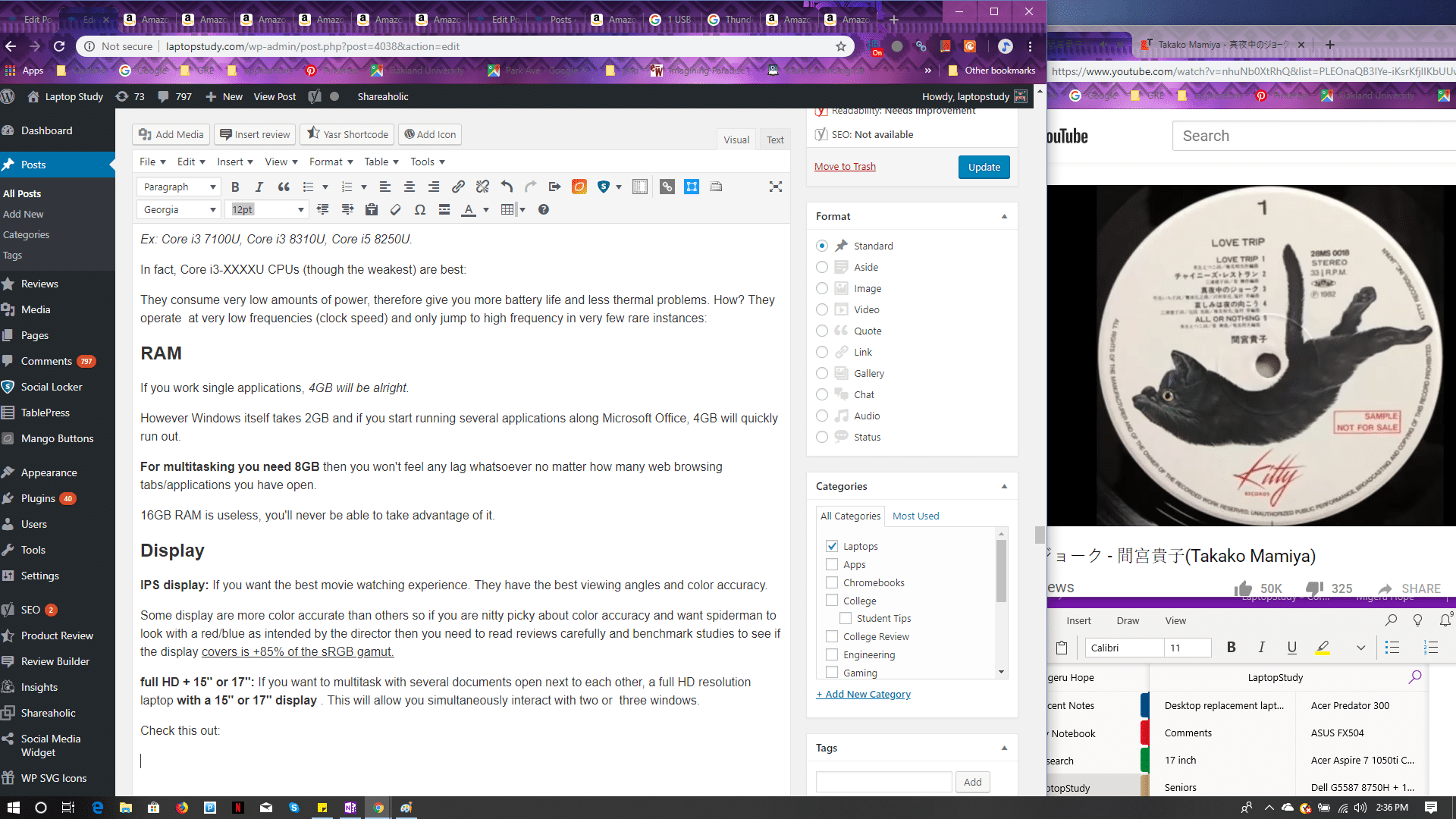
d) Storage
✅ SSD (Solid State Drive) = A MUST.
An SSD will make everything feel instantaneous:
🚀 Booting Windows = 1–2 seconds
🚀 Launching apps = near-instant
💡 128GB–256GB SSD is plenty, even for thousands of documents & photos/videos.
💾 How much can you fit in a 128GB–256GB SSD?
| Type | Size | 128GB | 256GB |
|---|---|---|---|
| Photos | 5MB each | ~25,000 | ~50,000 |
| Full HD Video | 200MB/hr | ~640 hours | ~1,280 hours |
| Screenshots | 44KB each | ~3 million | ~6 million |
| PDF Books | 14MB each | ~9,000 | ~18,000 |
| Windows 10 (64-bit) | ~20GB | ~ | ~ |
✅ HDD (Hard Disk Drive) – For extra storage (if needed).
- Slower than SSDs, but cheap & good for long-term storage.
- 1TB HDD = enough space for years of documents, movies, and games.
💡 With 15-17 inch laptops, you can usually add a second storage drive.
C) Storage
Solid State Drive
If you want to be really productive, you really should think about having an SSD on your laptop. Launching office, opening large spreadsheets and even booting your system will literally take 1 or 2 seconds.
Although SSDs may come with 128GB or 256GB for storage, this is plenty space even if you have several thousands of documents and hundreds of photos/videos.
Here’s how much you can fit in in a 128 or 256GB:
| Type | Size | 128GB | 256GB | |
| Photos | 6000X4000JPEG | 5MB | ~25000 photos |
~50 000 |
| Videos | 1h full HD 60fps |
200MB | ~640hours | ~ 1280 hours |
| Images | Screenshot PNG | 44k | 3 million | 6 million |
| Books | PdF – 170p. | 14MB | 9000 | 18 000 |
| Win10 | 64bit | 20GB | – | – |
Hard Disk Drive
These are the traditional storage drives you are used to.They are slow but they offer you with plenty of storage 1000GB(1TB) for a lifetime.
If you opt for a 15” or 17” laptop, there will be plenty of space to install an additional hard drive. Depending on what storage your laptop came with, you can either install a 1TB HDD or a 256GB SSD.
With 15-17inch laptops, the process is just as easy as removing one screw and inserting a USB storage device into a socket.
2. Gaming
No laptop on the market can fully match the performance of a desktop, but laptops are getting closer every day.
Even though laptops now use the same GPUs and CPUs as desktops, they still struggle to reach the same FPS and clock speeds.
💡 Why? Size and cooling.
- Laptops can’t handle high temperatures as well as desktops.
- The smaller the laptop, the worse the cooling = less performance.
TL;DR: In gaming, it’s all about two things:
✅ The GPU (Graphics Card)
✅ The Cooling System
a) CPU – Clock Speed Over Core Count
There are very few games that take advantage of multiple cores.
💡 Your priority? High clock speeds.
Most gaming CPUs already come with 4-6 cores, so you don’t really have a choice there.
Best Gaming CPUs:
| CPU | Base Speed | Turbo Boost | Cores |
|---|---|---|---|
| i5-8250U | 1.6GHz | 3.4GHz | 4 |
| i5-8300H | 2.3GHz | 4.0GHz | 4 |
| i7-7700HQ | 2.8GHz | 3.8GHz | 4 |
| i7-8550U | 1.8GHz | 4.0GHz | 4 |
| i7-8750H | 2.2GHz | 4.1GHz | 6 |
💡 Rule of thumb: Higher clock speeds = better gaming performance.
b) RAM – How Much Do You Need?
✅ 8GB RAM – Enough for FPS games like Overwatch & MOBA games like LoL/Dota 2.
✅ 16GB RAM – Needed for open-world RPG/MMORPGs like WoW or Skyrim at ultra settings.
c) Storage – Avoid HDDs Like the Plague
Storage might seem unimportant for gaming, but it actually makes a huge difference in open-world games.
Why? Games like WoW are constantly loading massive files every time you move into a new area.
🚨 Avoid HDDs (5400/7200 RPM).
A slow HDD will increase load times by minutes—yes, MINUTES.
✅ SSD (Solid State Drive) = A MUST.
✅ PCIe NVMe SSDs = The fastest storage option.
❌ FireCuda/Optane Memory = Marketing hype, avoid these.
💡 Best setup?
- SSD for the OS & games (128GB or 256GB minimum).
- Optional 1TB HDD for extra storage (movies, music, etc.).
d) GPU – The Most Important Component
💡 The better the GPU, the higher the FPS.
High-End Gaming GPUs (Ultra Settings, 60+ FPS, AAA Games)
| GPU | FPS in Open-World RPGs | FPS in FPS Games (Ultra Settings, 1080p) | FPS in MOBA Games (Ultra Settings, 1080p) |
|---|---|---|---|
| GTX 1060 / RTX 2060 | 60+ FPS | 100+ FPS | 150+ FPS |
| GTX 1070 / RTX 2070 | 80+ FPS | 120+ FPS | 180+ FPS |
| GTX 1080 / RTX 2080 | 100+ FPS | 150+ FPS | 200+ FPS |
Mid-Range Gaming GPUs (Medium Settings, 40–60 FPS, Light Gaming)
| GPU | FPS in Open-World RPGs | FPS in FPS Games (Medium Settings, 1080p) | FPS in MOBA Games (Ultra Settings, 1080p) |
|---|---|---|---|
| GTX 940M / MX150 / MX250 | 40 FPS | 50 FPS | 100+ FPS |
| GTX 1050 / 1050Ti | 50–60 FPS | 60+ FPS | 120+ FPS |
🚨 Key Takeaways:
- For AAA gaming, get GTX 1060 / RTX 2060 or better.
- For casual gaming, GTX 1050Ti or lower is fine.
e) Design & Cooling – The Secret to Real Performance
Most gamers only care about the CPU & GPU—big mistake.
💡 Here’s what manufacturers do:
1️⃣ Take the latest GPU & CPU
2️⃣ Shove them into a laptop
3️⃣ Ignore cooling & airflow
What happens? Terrible cooling = bad performance.
✅ Good cooling = Higher FPS & longer lifespan
❌ Bad cooling = Throttling, overheating, FPS drops
f) Overclocking & Throttling – Why Cooling Matters
A well-designed cooling system lets a CPU/GPU stay in turbo mode longer for max performance.
🚨 But with poor cooling?
- The CPU & GPU overheat, so the laptop reduces clock speeds (underclocking/throttling).
- You lose FPS and experience lag spikes.
✅ Best cooling setup?
- Dual-fan cooling with proper heat pipes.
- Vents positioned away from the bottom (so airflow isn’t blocked).
g) Display – Refresh Rates & G-Sync/FreeSync
1) Refresh Rate – FPS vs. Display Hz
🚨 60Hz vs. 120Hz vs. 300Hz – What’s the Difference?
- 60Hz refresh rate = Standard (found on most laptops).
- 120Hz+ refresh rate = Competitive gaming (CS:GO, Overwatch, etc.).
- 300Hz refresh rate = Top-tier gaming (not necessary for everyone).
💡 Don’t waste money on a high-end GPU if your display is bottlenecking it.
2) G-Sync/FreeSync – No More Screen Tearing
💡 G-Sync (NVIDIA) & FreeSync (AMD) help prevent screen tearing.
What’s Screen Tearing?

Your GPU controls how many FPS you get.
For example:
- Your RTX 2070 might be pushing 150 FPS.
- Your display is capped at 120Hz.
When FPS & refresh rates don’t match up, you get screen tearing.
✅ Solution? G-Sync/FreeSync syncs FPS with your display’s refresh rate.
💡 Laptops with 300Hz displays don’t really need G-Sync/FreeSync.
3. 3D Modeling, CAD Design, & Animation
For 3D work, there are three key factors that affect performance:
✅ CPU (for modeling, editing, and assembling projects)
✅ GPU (for viewport navigation & rendering)
✅ RAM (for handling large projects & rendering speed)
💡 Cooling design is also extremely important if you want your laptop to last several years while handling heavy rendering workloads.
a) CPU – High Clock Speeds for Modeling, More Cores for Rendering
1) Modeling & Editing
- Modeling, assembling, and applying effects rely heavily on clock speed.
- No single CAD/Animation software takes full advantage of multi-core CPUs.
- Only a few operations (like simulations in Revit, AutoCAD, or SolidWorks) benefit from more cores.
💡 If you want a fast modeling experience, prioritize a CPU with high clock speeds.
2) Rendering
- Rendering (no matter the software) uses multi-core CPUs.
- Performance gains decrease beyond 6 cores, but 8 cores is still beneficial.
Best CPUs for 3D Work
| CPU | Base Speed | Turbo Speed | Cores |
|---|---|---|---|
| i5-8250U | 1.6GHz | 3.4GHz | 4 |
| i5-8300H | 2.3GHz | 4.0GHz | 4 |
| i7-7700HQ | 2.8GHz | 3.8GHz | 4 |
| i7-8550U | 1.8GHz | 4.0GHz | 4 |
| i7-8750H | 2.2GHz | 4.1GHz | 6 |
| i7-9750H | 2.6GHz | 4.5GHz | 6 |
| i9-8950HK | 2.9GHz | 4.8GHz | 6 |
| i7-10750H | 2.6GHz | 5.0GHz | 6 |
| i9-10890K | 2.4GHz | 5.3GHz | 8 |
💡 For most CAD/3D modeling work, a high-clock-speed i7 or Ryzen 7 is the best choice.
💡 For rendering-heavy workloads, go for an i9 or Ryzen 9 with 6+ cores.
b) GPU – Do You Need a Workstation Graphics Card?
There are two types of GPUs:
1️⃣ Gaming GPUs (Consumer-Grade)
2️⃣ Workstation GPUs (Quadro, Radeon Pro, etc.)
💡 Do you need a workstation GPU? Most likely, NO.
✅ Gaming GPUs are better for 99.9% of users.
✅ Workstation GPUs (Quadro) are only useful for specialized SolidWorks plugins & massive CAD assemblies (5,000+ parts).
❌ Workstation GPUs are actually WORSE in some 3D software (like Maya & 3DS Max).
Best GPUs for 3D Work (Gaming vs. Workstation GPUs)
| GPU | CUDA Cores | VRAM | Performance Notes |
|---|---|---|---|
| MX150 | 384 | 2GB-4GB | Entry-level (small projects only) |
| GTX 1050 / 1050Ti | 640-768 | 2GB-4GB | Decent for students & beginners |
| GTX 1060 / 1660 Ti | 1280-1536 | 6GB | Best value for money (recommended) |
| RTX 2060 / 2070 | 1920-2304 | 6GB-8GB | High-end (great for animation & large scenes) |
| RTX 2080 / 2080 Ti | 2944-4352 | 8GB-11GB | Overkill unless rendering 24/7 |
💡 3D modeling software benefits from CUDA Cores & VRAM.
💡 For animation software (Maya, 3DS Max), higher VRAM is more important than core count.
💡 AutoCAD does NOT need more than 6GB of VRAM.
c) RAM – How Much Is Enough?
✅ 8GB RAM – Fine for small projects, students, and beginners.
✅ 16GB RAM – Best for serious 3D modeling, CAD, and animation work.
✅ 32GB RAM – Needed only for very large assemblies, advanced rendering, and simulations.
💡 Rendering? Get more RAM—it speeds up the process.
d) Storage – SSD Is a MUST
3D software takes up a LOT of space and loads massive files.
✅ SSD (Solid State Drive) – Essential for fast load times.
✅ HDD (Hard Disk Drive) – Good for storing finished projects.
💡 Best setup?
- SSD (256GB+ for OS & software).
- Optional 1TB HDD for storage.
💡 PCIe NVMe SSDs are faster than SATA SSDs—get one if possible.
e) Cooling System – Avoid Overheating & Performance Throttling
🚨 Why does cooling matter?
- Bad cooling = CPU & GPU get too hot → System throttles performance.
- Throttling = CPU/GPU slow down to avoid overheating → FPS drops & lag.
✅ Look for laptops with dual-fan cooling & proper ventilation.
✅ Avoid laptops with bottom-placed vents (airflow gets blocked on desks/laps).
💡 A well-cooled laptop can outperform a hotter laptop with better specs.
5. Video Editing
Video editing is one of the most hardware-intensive tasks a laptop can handle.
Unlike gaming or photo editing, video editing benefits from multiple cores, a powerful GPU, and lots of RAM.
💡 Key components that matter:
✅ CPU – More cores = faster rendering.
✅ GPU – Helps with rendering & playback (especially in 4K+).
✅ RAM – Large projects require lots of memory.
✅ Storage – SSD is essential for fast read/write speeds.
✅ Display – 1080p minimum, 4K preferred.
a) CPU – More Cores for Faster Rendering
- Editing & applying effects rely heavily on clock speed.
- Exporting & rendering benefit from multi-core processors (up to 8 cores).
💡 For desktop-level performance, aim for:
✅ Intel Core i7 or i9 (8th Gen or newer)
✅ AMD Ryzen 7 or 9
| CPU | Base Speed | Turbo Boost | Cores |
|---|---|---|---|
| i7-8750H | 2.2GHz | 4.1GHz | 6 |
| i7-9750H | 2.6GHz | 4.5GHz | 6 |
| i9-8950HK | 2.9GHz | 4.8GHz | 6 |
| i9-10890K | 2.4GHz | 5.3GHz | 8 |
| AMD Ryzen 7 4800H | 2.9GHz | 4.2GHz | 8 |
| AMD Ryzen 9 4900HS | 3.0GHz | 4.3GHz | 8 |
💡 For 4K video editing, go for an i9 or Ryzen 9 with at least 6 cores.
b) RAM – How Much Do You Need?
✅ 8GB RAM – Enough for basic 1080p video editing (less than 60 minutes of footage).
✅ 16GB RAM – Recommended for 1080p+ editing with effects, layers, and transitions.
✅ 32GB RAM – Necessary for 4K video editing, heavy After Effects work, and large projects.
💡 Video editing software consumes a lot of RAM. If you work with large files, 16GB+ is strongly recommended.
c) GPU – Helps with Rendering & Playback
- A powerful GPU speeds up rendering and smooths out playback.
- If you’re working with 4K footage or high-resolution effects, a dedicated GPU is essential.
✅ Best GPUs for Video Editing:
| GPU | CUDA Cores | VRAM | Best For |
|---|---|---|---|
| GTX 1050 / 1050Ti | 640-768 | 2GB-4GB | Basic 1080p editing |
| GTX 1060 / 1660 Ti | 1280-1536 | 6GB | Smooth performance in Premiere Pro, DaVinci Resolve |
| RTX 2060 / 2070 | 1920-2304 | 6GB-8GB | Best for 4K+ editing & VFX work |
| RTX 2080 / 2080 Ti | 2944-4352 | 8GB-11GB | Overkill unless working with ultra-heavy VFX |
💡 For most users, a GTX 1660 Ti or RTX 2060 is more than enough.
💡 For high-end 4K+ editing, an RTX 2070 or better is ideal.
d) Storage – SSDs Are a Must
Video files are large, and slow storage can bottleneck performance.
🚨 SSD vs. HDD – Why It Matters
| Storage Type | Read/Write Speed | Best For |
|---|---|---|
| HDD (Hard Drive) | 50–120 MB/s | Storing finished projects, archival storage |
| SATA SSD | 500 MB/s | A budget-friendly option for faster project access |
| PCIe NVMe SSD | 1500–3500 MB/s | Best for 4K+ editing, ultra-fast workflow |
💡 Best setup:
- SSD (512GB+) for OS, software, & active projects.
- HDD (1TB+) for long-term storage.
💡 If possible, get two SSDs:
1️⃣ One for Windows & software
2️⃣ One for projects & cache files
e) Display – Resolution & Color Accuracy Matter
1) Screen Resolution
✅ 1080p (Full HD) – Minimum requirement for video editing.
✅ 4K (UHD) – Best for detailed editing & high-resolution content.
💡 Even with a 4K display, editing software will scale down your video so you can see the timeline & tools.
2) Color Accuracy – sRGB & Adobe RGB
- For professional color grading, you need a color-accurate display.
- Look for 100% sRGB or Adobe RGB coverage.
✅ Best Display Features for Video Editing:
- IPS panel (for better viewing angles & colors).
- 100% sRGB or Adobe RGB.
- Factory color calibration.
💡 For serious color work, consider an external monitor with better color accuracy.
6. Desktop Replacement Laptop Tips
Choosing the right desktop replacement laptop isn’t just about getting the most powerful specs—you also need to consider upgradeability, cooling, battery life, and other practical aspects.
💡 Key things to look out for:
✅ Upgradeability – Can you add more RAM or storage later?
✅ GPU – Is it powerful enough for your needs?
✅ Cooling System – Does it prevent overheating and performance throttling?
✅ Battery Life – Can it run unplugged for long periods?
✅ External Display Support – Can you connect extra monitors?
a) Upgradeability – Future-Proof Your Laptop
Most 15″ and 17″ laptops allow for RAM and storage upgrades.
✅ RAM Upgrades:
- Many laptops support up to 32GB or even 64GB RAM.
- If unsure, start with 8GB and upgrade later.
✅ Storage Upgrades:
- Many desktop replacement laptops allow for an extra SSD or HDD.
- Some models have dual SSD slots (NVMe + SATA) or an extra 2.5” HDD bay.
- If you work with large files, look for laptops with multiple storage slots.
🚨 Before buying, check if RAM & storage are upgradeable. Some ultra-thin laptops have soldered RAM!
b) Should You Go Beyond 16GB RAM?
For most users, 16GB RAM is enough.
💡 However, certain users might need more:
- CAD designers (handling models with thousands of parts).
- Programmers (running multiple virtual machines).
- Video editors (multitasking with Adobe Premiere & After Effects).
✅ For these users, 32GB RAM (or even 64GB) may be useful.
c) GPU – Integrated vs. Dedicated Graphics
1) Integrated Graphics (Intel UHD, Iris, Radeon Vega)
✅ Good for: Office work, web browsing, movies, light gaming.
❌ Bad for: 3D rendering, gaming, video editing.
💡 All Intel UHD/Iris and AMD Vega integrated GPUs perform similarly—don’t stress about which one you get.
2) Dedicated Graphics (For Gaming, 3D Work, and Editing)
✅ These GPUs have:
- Their own memory (VRAM), which prevents lag when handling graphics-heavy tasks.
- CUDA cores (NVIDIA) or Stream processors (AMD), which speed up rendering and simulations.
✅ Best GPUs for Performance Users:
| GPU | CUDA Cores | VRAM | Best For |
|---|---|---|---|
| MX150 / 940MX | 384 | 2GB-4GB | Light gaming, office work |
| GTX 1050 / 1050Ti | 640-768 | 2GB-4GB | Mid-range gaming, 1080p editing |
| GTX 1060 / 1660 Ti | 1280-1536 | 6GB | 3D modeling, animation, video editing |
| RTX 2060 / 2070 | 1920-2304 | 6GB-8GB | 4K editing, high-end gaming |
| RTX 2080 / 2080 Ti | 2944-4352 | 8GB-11GB | VR, extreme workloads |
💡 For gaming or 3D work, aim for at least a GTX 1660 Ti or RTX 2060.
d) Max-Q GPUs – What Are They?
Max-Q GPUs are underclocked versions of full-power GPUs, designed for thin & light gaming laptops.
💡 Example:
A GTX 1060 Max-Q performs 10–20% slower than a regular GTX 1060, but generates less heat & extends battery life.
🚨 Max-Q GPUs are great for portability, but if you want full performance, avoid them.
e) RTX GPUs – Are They Worth It?
✅ RTX GPUs have:
- Tensor Cores & RT Cores for AI acceleration & real-time ray tracing.
- Better rendering speeds for 3D work & video editing.
💡 Best value: RTX 2060 – Offers the best performance-to-price ratio.
🚨 Higher-end RTX GPUs (2070, 2080) offer diminishing returns unless you need extreme performance.
f) GPU Switching – Why Your Laptop Might Be Underperforming
If your 3D software, game, or rendering program is running slow, your laptop might be using integrated graphics instead of your dedicated GPU.
✅ Fix it by:
1️⃣ Going to NVIDIA Control Panel or AMD Radeon Settings.
2️⃣ Manually setting the program to use your dedicated GPU.
3️⃣ Restarting your software to apply the changes.
💡 Switch back to integrated graphics when doing light tasks to extend battery life.
g) Cooling System – The Most Overlooked Factor
🚨 Why cooling matters:
- Bad cooling = CPU & GPU get too hot → Performance throttling.
- Throttling = CPU/GPU slow down to avoid overheating → FPS drops & lag.
✅ Best cooling features to look for:
- Dual-fan cooling with good heat pipe placement.
- Vents that aren’t blocked when placed on a desk.
- Metal chassis (helps dissipate heat better than plastic).
💡 A well-cooled laptop can outperform a laptop with better specs but poor airflow.
h) Battery Throttling – Why Your Laptop Slows Down on Battery Power
Some gaming & workstation laptops throttle performance when unplugged because:
1️⃣ The battery isn’t powerful enough to supply full power.
2️⃣ The system lowers power consumption to extend battery life.
💡 To fix this:
- Keep the laptop plugged in while gaming or rendering.
- Go to Power Settings and set it to “High Performance” mode.
i) External Monitors – Should You Keep Your Desktop Monitor?
✅ Most modern laptops support external displays via HDMI, DisplayPort, or USB-C.
💡 Multiple monitor setups boost productivity.
Example setup:
- Main laptop screen for editing.
- External monitor for full-screen previews or extra workspace.
🚀 Some high-end laptops even support up to 3 external monitors.
Author Profile
- I am physicist and electrical engineer. My knowledge in computer software and hardware stems for my years spent doing research in optics and photonics devices and running simulations through various programming languages. My goal was to work for the quantum computing research team at IBM but Im now working with Astrophysical Simulations through Python. Most of the science related posts are written by me, the rest have different authors but I edited the final versions to fit the site's format.
Latest entries
 wowDecember 18, 20255 Best Laptops For World of Warcraft – Midnight & Classic (2026)
wowDecember 18, 20255 Best Laptops For World of Warcraft – Midnight & Classic (2026)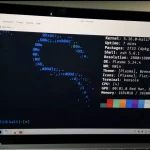 LaptopsDecember 17, 2025The 4 Best Laptops For Virtualization of 2026 (10-50 VMs ATSM)
LaptopsDecember 17, 2025The 4 Best Laptops For Virtualization of 2026 (10-50 VMs ATSM) Hardware GuideDecember 17, 20252026 Beginner Guide to Reading Computer (Laptop) Specifications
Hardware GuideDecember 17, 20252026 Beginner Guide to Reading Computer (Laptop) Specifications LaptopsJune 30, 2025Best Laptops for Computer Science (July 2025 )
LaptopsJune 30, 2025Best Laptops for Computer Science (July 2025 )


